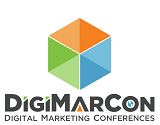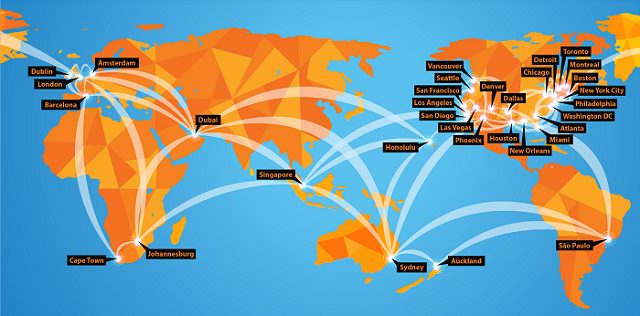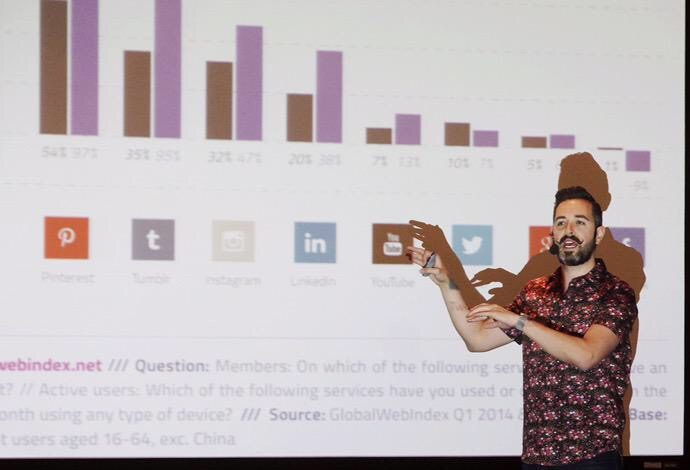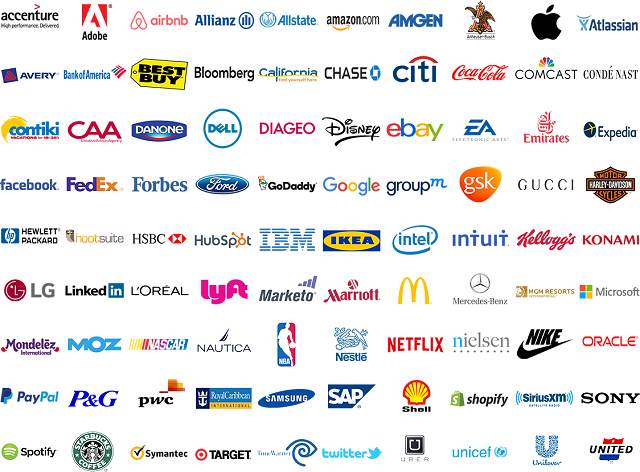Posts Tagged "Digital Marketing Tactics"
Articles
- Best Marketing Conference Sponsorship
- What Does it Mean to Be an Exhibitor at a Conference?
- What Is the Biggest Social Media Conference?
- What Is an Innovation Conference?
- What Is a Typical B2B Event?
- What Are the Cloud Technology Events in 2025?
- Marketing Event Volunteer Opportunities: A Comprehensive Guide
- Digital Marketing Event Volunteer Opportunities Near Me
- What Does a Volunteer Do at a Conference?
- Is DigiMarCon Worth It?
- Is DigiMarCon Good?
- What is the Biggest Marketing Forum?
- What are Digital Marketing Conferences?
- Marketing Conference Exhibiting: Your Guide to Success
- Digital Summit Comparison: A Closer Look at DigiMarCon
- Digital Marketing Conference
- Digital Marketing Events: Your Guide to Success in 2025
- Marketing Conferences: Unlocking Your Business Potential in 2025
- What Is The Future of Digital Marketing in 2030?
- B2B Event Marketing Strategy: Unlocking Success For Your Business
- Why B2B Event Marketing?
- What Should a B2B Marketing Strategy Include?
- Top Marketing Conferences for 2025
- What Is the Future of Marketing in 2025?
Digital Marketing Conferences
- NORTH AMERICA
- DigiMarCon Cruise
(New Orleans, LA, USA) - DigiMarCon West
(Los Angeles, CA, USA) - DigiMarCon Northwest
(Seattle, WA, USA) - DigiMarCon Canada West
(Vancouver, BC, USA) - DigiMarCon Canada
(Toronto, ON, Canada) - DigiMarCon Canada East
(Montreal, QC, Canada) - DigiMarCon Florida
(Orlando, FL, USA) - DigiMarCon Gulf Coast
(Houston, TX, USA) - DigiMarCon Southern California
(San Diego, CA, USA) - DigiMarCon Midwest
(Chicago, IL, USA) - DigiMarCon Mid-South
(Nashville, TN, USA) - DigiMarCon Great Lakes
(Detroit, MI, USA) - DigiMarCon North
(Minneapolis, MN, USA) - DigiMarCon Central
(Kansas City, MO, USA) - DigiMarCon Texas
(Dallas, TX, USA) - DigiMarCon New England
(Boston, MA, USA) - DigiMarCon Mid-Atlantic
(Philadelphia, PA, USA) - DigiMarCon South Florida
(Miami, FL, USA) - DigiMarCon Southeast
(Atlanta, GA, USA) - DigiMarCon Central Florida
(Tampa, FL, USA) - DigiMarCon East
(New York, NY, USA) - DigiMarCon South Atlantic
(Charlotte, NC, USA) - DigiMarCon America
(Washington, D.C. USA) - DigiMarCon Northern California
(San Francisco, CA, USA) - DigiMarCon Rocky Mountains
(Denver, CO, USA) - DigiMarCon South
(San Antonio, TX, USA) - DigiMarCon Silicon Valley
(San Jose, CA, USA) - DigiMarCon Orange County
(Anaheim, CA, USA) - DigiMarCon Southwest
(Phoenix, AZ, USA) - DigiMarCon World
(Las Vegas, NV, USA)
- DigiMarCon Cruise
- LATIN AMERICA
- EUROPE
- MIDDLE EAST
- AFRICA
- ASIA PACIFIC
- DigiMarCon Hawaii & Pacific
(Honolulu, HI, USA) - DigiMarCon Asia & Japan
(Tokyo, Japan) - DigiMarCon New Zealand
(Auckland, New Zealand) - DigiMarCon Australia
(Sydney, Australia) - DigiMarCon Oceania
(Melbourne, Australia) - DigiMarCon Southeast Asia
(Singapore) - DigiMarCon India
(New Delhi, India) - DigiMarCon North Asia & China
(Shanghai, China)
- DigiMarCon Hawaii & Pacific
- VIRTUAL
Digital Marketing Blog
- What Makes DigiMarCon Stand Out (And Is It Worth It?) October 30, 2025
- Is DigiMarCon Worth Attending? A Complete Breakdown October 29, 2025
- DigiMarCon for Startups: Why Founders Shouldn’t Miss It October 29, 2025
- DigiMarCon Recap: What Went Down and What’s Next October 29, 2025

































Effective Social Media Marketing Strategies for Success
In today’s digital world, having a strong online presence is key for businesses to thrive. If you’re in digital marketing or leading a business, you know how vital it is to use online platforms to connect with your audience.
The digital marketing world is always changing. This article will cover the latest in online marketing, setting goals, and strategies that work. By the end, you’ll know how to improve your online presence and boost your business.
Key Takeaways
The Current Social Media Landscape
Understanding the fast-changing social media world is key. Marketers need to know about user trends and platform updates. This knowledge helps in creating effective online marketing plans.
Platform Demographics and User Behavior
Each social media site draws different people. For example, TikTok and Instagram are popular with the young. Meanwhile, LinkedIn is favored by professionals. Knowing this helps in targeting the right audience with digital ads.
Recent Algorithm Changes Affecting Marketing
Social media algorithms keep changing, affecting how we see content. New updates focus on user engagement and content relevance. Marketers must adjust their strategies to stay seen and reach their audience.
By keeping up with these updates, marketers can make their online marketing better. This leads to more effective digital ads.
Setting Clear Social Media Marketing Goals
Creating a strong social media marketing plan starts with clear goals. “You can’t manage what you don’t measure,” says Peter Drucker. This is especially true for social media marketing.
Defining SMART Objectives
Social media goals need to be SMART: Specific, Measurable, Achievable, Relevant, and Time-bound. For example, instead of saying “increase brand awareness,” aim to “boost Instagram followers by 20% in 6 months with targeted content and engagement.”
Aligning Social Media Goals with Business Outcomes
Social media goals must match the company’s bigger goals. This makes sure social media helps the business succeed. For example, if a company wants to sell more, its social media goals might be to get more website visitors or leads.
Benchmarking Against Competitors
Looking at what competitors do on social media is helpful. It shows what’s common and where you can stand out. By studying competitors, businesses can find new ways to be better.
With clear, aligned, and benchmarked goals, businesses can make their social media marketing stronger. This leads to better social media engagement strategies and Social Media Marketing Strategies.
Social Media Marketing Strategies That Drive Results
The secret to successful social media marketing is to use strategies that match your business goals. To see real results, focus on building a strong online presence that speaks to your audience.
Content-First Approach
Putting content first is key in social media marketing. High-quality, relevant content attracts and keeps your audience. Create a content plan that includes informative, entertaining, and engaging content for different audience segments.
Use various content types like videos, blog posts, and infographics to keep people interested. It’s also important to optimize content for different social media platforms. This means using each platform’s unique features and how users behave.
Community Building Tactics
Building and engaging with your community is crucial. This means creating a brand community by fostering interactions through comments, messages, and reviews. You can do this by hosting webinars, creating Facebook groups, and running contests.
To build a strong community, engage consistently and respond personally to your audience. This builds trust and loyalty, leading to more conversions and growth.
Conversion-Focused Strategies
Conversion-focused strategies aim to get specific actions from your audience. Create social media campaigns that meet your business goals, like generating leads, driving sales, or increasing website traffic. Use tactics like limited-time offers, exclusive deals, and ads to boost conversions.
To get the most conversions, track and analyze your social media performance. This helps you find what works and improve your strategies.
Platform-Specific Tactics for Maximum Impact
To make a big splash in social media, marketers need to use tactics made for each platform. Each platform has its own special chances and challenges. So, it’s key to have strategies that fit each one well.
Facebook Marketing Techniques
Facebook is still a top spot for marketers. It has a huge number of users and lots of ways to advertise. Good digital advertising techniques on Facebook include:
Instagram Growth Approaches
Instagram is all about pictures and videos. To grow on Instagram, you need:
LinkedIn for B2B Success
LinkedIn is perfect for B2B marketers. It’s all about connecting with professionals. Good strategies include:
TikTok and Short-Form Video Strategies
TikTok is all about short videos. To do well, you need:
Trending Audio Utilization
Using popular audio can really get people engaged on TikTok. Keep up with the latest trends and add them to your videos.
Hashtag Strategy for Discovery
Hashtags are key to getting found on TikTok, just like on Instagram. Find and use the right hashtags to make your content more visible.
By knowing and using these platform-specific tactics, marketers can boost their social media engagement strategies. This way, they can make a big impact on different platforms.
Content Creation Best Practices
Content creation is key in social media marketing. It drives engagement and conversions. Marketers need a strong content strategy that speaks to their audience.
Visual Content That Drives Engagement
Visual content grabs attention and boosts interaction. Using high-quality images, videos, and infographics can increase engagement. For example, tweets with images get 150% more retweets than those without.
Copywriting Formulas for Social Media
Good copywriting is vital for sharing your brand’s message. Using formulas like AIDA or PAS can make your social media posts effective. Make sure your message fits your audience’s needs for the best results.
User-Generated Content Implementation
User-generated content (UGC) is a treasure for social media marketers. It’s authentic and engaging. But, setting up UGC campaigns needs careful planning.
UGC Campaigns That Convert
To succeed with UGC, offer incentives for users to share their brand experiences. A contest or giveaway can spark user-generated content.
Legal Considerations for UGC
UGC campaigns come with legal hurdles. Brands must get the right permissions to use user content. Clear terms and conditions are crucial.
By following these content creation tips, businesses can boost their online presence. They can drive engagement and meet their marketing goals.
Building and Nurturing Your Community
Creating a loyal community around your brand is key to long-term success on social media. Marketers can do this by engaging with their audience and creating meaningful interactions. This way, they build a community that supports the brand and drives business outcomes.
Community Management Frameworks
Effective community management is essential for any successful social media strategy. To manage your community well, consider these frameworks:
Response Strategies for Comments and Messages
Responding to comments and messages is crucial for building trust and fostering engagement. Here are some strategies to consider:
Creating Interactive Experiences
Interactive experiences are vital for keeping your community engaged. Some effective techniques include:
By using these strategies, you can create a vibrant and engaged community. This community will support your brand’s marketing goals.
Paid Social Media Advertising Tactics
In the world of social media, paid ads help businesses shine. Marketers use various tactics to boost engagement, conversions, and revenue. This is key to success.
Ad Format Selection and Optimization
Choosing the right ad format is vital. Formats like images, videos, carousels, and stories each have their own strengths. Optimizing ad creative for these formats can greatly improve results. High-quality visuals and compelling copy can boost engagement.
Advanced Targeting and Retargeting Approaches
Advanced targeting lets advertisers reach specific audience segments. Retargeting campaigns target users who’ve shown interest but haven’t converted. These strategies make paid social media campaigns more effective.
Budget Allocation for Maximum ROI
Effective budget allocation is key for ROI in paid social media ads. It’s about setting the right budget and allocating it wisely. A/B testing helps find the best strategies.
A/B Testing Methodologies
A/B testing compares two ad versions to see which works better. This helps refine paid social media tactics, improving campaign results.
Scaling Successful Campaigns
Scaling successful campaigns can amplify their impact. This means increasing budget, expanding audience, or optimizing ads. Continuous monitoring ensures the campaign stays effective as it grows.
Leveraging Influencer Partnerships
Influencer marketing has become a key tool for brands to reach new people and gain trust on social media. By teaming up with influencers, brands can create content that truly connects with their audience.
Identifying Aligned Influencers for Your Brand
Finding the right influencers is key to successful influencer marketing. You need to look at their content, how engaged their followers are, and who they are talking to. This ensures they match your brand and audience.
Structuring Performance-Based Campaigns
Creating campaigns that focus on results is essential. Set clear goals, like increasing sales or engagement, and track how well they do. Use special links to see how your campaign is doing.
Measuring Influencer Marketing Impact
To see if influencer marketing is working, you need to track its results. Look at things like how many people are engaging, how many are buying, and how much money you’re making back.
Analytics and Performance Measurement
Understanding social media marketing success requires a deep look at analytics and performance. Businesses must track key performance indicators (KPIs) on various social media platforms. This helps measure their efforts’ success.
Essential Metrics to Track by Platform
Different social media platforms offer unique metrics for performance tracking. On Facebook, engagement metrics like likes, comments, and shares are key. Instagram focuses on story views and swipe-through rates for user interaction insights. LinkedIn’s click-through rates and post engagement are vital for B2B marketing success.
Attribution Modeling for Social Media
Attribution modeling is essential for understanding social media’s impact on business outcomes. It helps marketers see which social media interactions lead to conversions or sales. This way, they can better allocate resources and improve marketing strategies.
Turning Data into Strategic Decisions
The real value of analytics is in making data-driven decisions. By analyzing performance data, marketers can spot areas for improvement. They can then optimize content and advertising, leading to better business results. This involves regularly reviewing metrics, adjusting campaigns, and staying current with social media analytics trends.
By using these analytics and performance strategies, businesses can improve their social media marketing. They can enhance their online presence and achieve marketing goals more effectively.
Social Media Marketing Automation and Tools
Social media marketing tools have become key in today’s fast-paced world. They help businesses manage their online presence better. This makes their marketing efforts more efficient and effective.
Content Planning and Scheduling Platforms
Keeping a steady flow of content on social media is vital. Tools like Hootsuite and Buffer make this easier. They let marketers schedule posts for different times, saving time and effort.
Creative Asset Development Tools
Automation tools also play a big role in creating content. Canva and Adobe Creative Cloud offer easy-to-use design tools. They help marketers make professional-looking content without needing to be designers.
Key Features of Creative Asset Development Tools:
Analytics and Reporting Solutions
Measuring campaign success is crucial. Tools like Sprout Social and Google Analytics give valuable insights. They show how well content is doing and help make informed decisions.
Using these tools can save businesses a lot of time. It also helps them improve their content and understand their audience better. This approach is vital for staying ahead in the digital world.
Emerging Trends Shaping the Future of Social Media Marketing
Looking ahead, several trends are set to change social media marketing. The field is always evolving, thanks to new tech and how people use it. Marketers need to keep up with these changes to stay innovative in their social media marketing strategies.
AI and Machine Learning Applications
Artificial intelligence (AI) and machine learning are changing social media marketing. They make digital advertising techniques smarter, like predictive analytics and tailored content. With AI, marketers can make customer experiences better and campaigns more effective.
Social Commerce Evolution
Social commerce is growing fast, with shopping features now part of social media. This shift changes how people shop online, making it simpler to find and buy products right on social media.
Privacy Changes and Their Impact
Recent privacy updates are big for social media marketing. Marketers must adjust by using first-party data and creating ads that respect privacy. This way, they can still target ads effectively.
Conclusion
The world of social media is always changing. Businesses need to keep up with these changes to stay ahead. By understanding the current trends, setting clear goals, and using the right Social Media Marketing Strategies, companies can improve their online presence.
Creating engaging content is key. Businesses should also use the latest tools and trends. They should always check how well their efforts are working and make changes as needed.
This way, they can build a strong social media presence. This presence will connect with their audience and help them succeed in the long run.
In today’s digital world, a good social media strategy is essential. By using the strategies and tactics from this article, companies can outdo their competitors. They can also reach their marketing goals.
FAQ
What are the most effective social media marketing strategies for success?
To succeed in social media marketing, focus on creating great content first. Build a community and engage with it. Also, use strategies that help you achieve your business goals.
How do I set clear social media marketing goals?
Start by setting SMART goals. Make sure they are specific, measurable, achievable, relevant, and time-bound. Align these goals with your business’s bigger picture. Compare them to your competitors to focus your efforts.
What are the best practices for creating engaging content on social media?
For engaging content, use visuals that grab attention. Write compelling copy for social media. Also, run campaigns that encourage users to create content for you. This builds authenticity and community.
How can I leverage influencer partnerships for my brand?
Find influencers who match your brand’s values. Set up campaigns that reward them for their work. Track how well these partnerships work to improve your marketing.
What are the essential metrics to track for social media performance measurement?
Key metrics include engagement rates, follower growth, and conversions. These help you see if your social media marketing is working. They guide your future strategies.
How can social media marketing automation tools improve my marketing efforts?
Automation tools help by making planning and scheduling easier. They improve creative work and offer insights into your performance. This saves time and helps you understand your audience better.
What emerging trends should I be aware of in social media marketing?
Keep an eye on AI, machine learning, and social commerce. Also, watch for privacy changes. These trends will shape your marketing strategies and need constant attention.
Paid Search Marketing: Unlock Your Online Potential
In today’s digital world, businesses are always looking for ways to reach more people. Paid Search Marketing is a key strategy. It helps companies show up more online and get more customers.
Using digital advertising platforms, businesses can make ads that speak to their audience. This boosts brand awareness and brings in real results. It’s a must-have for businesses wanting to succeed online.
Key Takeaways
Understanding Paid Search Marketing
Paid search marketing is key in today’s digital world. It helps businesses find customers who are looking for what they offer.
The Fundamentals of Pay-Per-Click Advertising
Pay-Per-Click (PPC) advertising is a big part of paid search marketing. Advertisers pay each time someone clicks on their ad. PPC advertising works well because it targets people who are actively searching for something.
How the Auction System Works
The auction system is at the heart of PPC advertising. When someone searches for a keyword, an auction happens. Advertisers who have bid on that keyword compete. The highest bidder, along with other factors like Quality Score, decides where the ad will show up.
Cost Structures in PPC
It’s important to understand the costs in PPC to manage budgets well. Advertisers need to think about Cost Per Click (CPC), the cost of each click, and their overall budget.
How Paid Search Differs from Organic Search
Paid search and organic search are different ways to show up on search engine results pages. Organic search aims to rank higher naturally by optimizing website content. Paid search, on the other hand, involves paying for ad spots. Paid search gives quick visibility and can be very targeted.
The Evolution of Search Engine Marketing
Search Engine Marketing (SEM) has changed a lot over time. It started with simple text ads and now includes advanced targeting and ad formats. Today, SEM includes PPC, Shopping Ads, and Display Ads.
The Benefits of Paid Search Marketing for Businesses
Paid search marketing offers many benefits for businesses. It provides quick visibility, precise targeting, and measurable ROI. A good pay-per-click strategy can greatly improve a business’s online presence and bring in more targeted traffic.
Immediate Visibility and Traffic Generation
Paid search marketing lets businesses quickly appear on search engine results pages (SERPs). Unlike organic search, which takes months, paid search can start bringing traffic in hours. This fast visibility is key for businesses wanting to grab their audience’s attention quickly.
Key benefits of immediate visibility include:
Precise Targeting Capabilities
Paid search marketing offers precise targeting. Businesses can use various options to ensure their ads reach the right people at the right time.
Geographic Targeting
Businesses can target users by location. This is great for local businesses or those focused on a specific region.
Demographic Targeting
Demographic targeting lets businesses target users by age, gender, and interests. This allows for very tailored marketing campaigns.
Device Targeting
With more people using mobile devices, device targeting is key. Businesses can make sure their ads work well on desktops, tablets, or mobiles, giving a smooth experience everywhere.
Measurable ROI and Performance Tracking
Paid search marketing also lets businesses measure ROI precisely. They can track ad performance, from click-through rates to conversion rates.
Key metrics to track include:
By looking at these metrics, businesses can improve their paid search strategies. This leads to better ROI and more effective campaigns.
Major Paid Search Platforms and Their Unique Features
Businesses want to make their mark online. Knowing the top paid search platforms is key. A few big names stand out, each with special features for advertisers.
Google Ads: The Industry Leader
Google Ads is the top choice for paid search. It has unmatched reach and targeting. Its success comes from its huge network and new features.
Search Network Campaigns
Google Ads’ Search Network lets you target users searching for specific keywords. It’s great for businesses wanting to catch users ready to buy.
Display Network Opportunities
Google Ads’ Display Network is huge for visual ads. It shows ads on millions of websites and apps. It’s perfect for increasing brand awareness and reaching more people.
Microsoft Advertising (Bing Ads)
Microsoft Advertising, once Bing Ads, is a big deal too. It targets specific groups well. It’s good for reaching certain demographics.
Amazon Advertising for E-commerce
Amazon Advertising is a must for online shops. It lets you advertise to Amazon users. This boosts sales and gets your products seen more.
Other Emerging Platforms
New players are joining the paid search scene. Social media and niche networks offer new ways to target and reach people.
In short, knowing each platform’s strengths is vital for a good digital ad plan. Using these platforms well can improve your online presence, drive traffic, and increase sales.
Building a Successful Paid Search Marketing Strategy
Creating a winning Paid Search Marketing strategy needs a few key steps. You must have clear goals, know your audience, and understand your competitors. This approach helps boost your online presence and increase conversions.
Setting Clear Campaign Objectives
It’s important to set specific goals for your Paid Search Marketing campaign. These goals should match your business aims, like more website visits, leads, or sales. Having clear goals helps focus your campaign and measure its success.
Understanding Your Target Audience
Knowing who your audience is is crucial in Paid Search Marketing. You need to find out their demographics, interests, and behaviors. Targeting your ads well ensures they reach people who are likely to buy.
Competitive Analysis and Benchmarking
Doing a competitive analysis helps you see where you stand in the market. It shows you how to beat your rivals. By comparing yourself to others, you can make your campaign better.
Budget Planning and Allocation
Planning your budget is key in Paid Search Marketing. You need to decide how much to spend and where. A good budget plan means your campaigns have enough money to work well and make a profit.
Daily vs. Lifetime Budgets
When setting your budget, you have to choose between daily and lifetime budgets. Daily budgets control your daily spending, while lifetime budgets set a total cap for the campaign. Choosing the right budget depends on your campaign’s goals and how long it will run.
Seasonal Budget Adjustments
Seasonal changes can affect your Paid Search Marketing. Adjusting your budget with the seasons can help you make more money during busy times and save during slow times.
By using these steps in your Paid Search Marketing strategy, you can make a strong campaign that gets results. Always keep an eye on your campaign and make changes as needed to keep it successful.
Keyword Research and Selection for PPC Campaigns
Effective keyword research is key to a successful PPC campaign. It helps businesses find their target audience with ease. By picking the right keywords, advertisers can boost their campaign’s visibility and ROI.
Identifying High-Value Keywords
Finding high-value keywords requires a deep dive into audience behavior and industry trends. Tools like Google Keyword Planner and SEMrush are great for this. They offer insights into search volume, competition, and costs.
Understanding Keyword Match Types
Keyword match types show how closely a search must match a keyword to show an ad. Knowing these types is key for better campaign optimization.
Broad Match
Broad match keywords have the widest reach. They can show ads for searches with misspellings, synonyms, and related terms.
Phrase Match
Phrase match keywords strike a balance between reach and specificity. They show ads for searches with the keyword phrase, possibly with more words.
Exact Match
Exact match keywords are the most specific. They only show ads for searches that closely match the keyword.
Negative Keywords and Their Importance
Negative keywords are vital for avoiding irrelevant searches. This saves budget and boosts campaign efficiency. Regularly check search terms reports to find potential negative keywords.
Tools for Effective Keyword Research
Many tools help with keyword research, including Google Keyword Planner, Ahrefs, and SEMrush. These tools offer insights into keyword performance, competition, and opportunities.
Creating Compelling Ad Copy and Landing Pages
In the world of online ads, standing out is key. You need more than just the right keywords. Your ad copy must grab attention, and your landing pages must meet expectations. A good pay-per-click strategy means making ads that draw people in and landing pages that convert.
Writing High-Converting Ad Headlines
Creating headlines that work means knowing what your audience likes. Use action words and include keywords to get more clicks.
Crafting Persuasive Ad Descriptions
Ad descriptions should keep the interest alive. Here’s what to include:
Including Strong Calls-to-Action
A good call-to-action (CTA) is key to getting people to act. Use CTAs like “Sign Up Now” or “Get Started Today” to guide users.
Highlighting Unique Selling Propositions
Your ad should clearly state what’s unique about your offer. This could be a special deal, a unique feature, or better service.
Designing Landing Pages That Convert
Landing pages should aim for one thing: conversion. Make sure your landing page matches your ad, is easy to use, and has a clear call-to-action.
A/B Testing for Continuous Improvement
A/B testing is vital for making your ads and landing pages better. By trying different versions, you can see what works best and boost your conversion rates.
By focusing on these areas, businesses can make their online ads more effective. This leads to higher conversion rates and better returns on investment.
Advanced Paid Search Marketing Techniques
Advanced paid search marketing is key to boosting ROI and beating competitors online. As the digital world changes, marketers need smart strategies to make their campaigns better.
Remarketing and Audience Targeting
Remarketing helps businesses reach out to users who’ve shown interest before. This can lead to more sales. By focusing on specific groups, ads can speak directly to potential buyers. Effective remarketing strategies use data on user behavior, like what they’ve looked at or added to cart.
Ad Extensions to Enhance Performance
Ad extensions add extra details to ads, making them more visible and appealing. They help improve ad performance and get more people to take action.
Sitelink Extensions
Sitelink extensions link to specific pages on a website. This makes it easier for users to find what they’re looking for, boosting click rates.
Callout Extensions
Callout extensions highlight special offers or benefits. They make ads more attractive to potential customers.
Structured Snippet Extensions
Structured snippet extensions give more context by showing specific details about a business. This could be product categories or services.
Dynamic Search Ads and Automated Bidding
Dynamic search ads create ad headlines and landing pages based on website content. This covers more search queries. Automated bidding, like Google Ads’ Smart Bidding, uses AI to set bids for each auction. This maximizes ROI.
Automated bidding cuts down on manual work while boosting campaign performance. It uses past data and current signals to adjust bids as needed.
Local PPC Strategies for Brick-and-Mortar Businesses
Local PPC is vital for businesses with physical stores. It attracts nearby customers. By targeting local keywords and using geo-targeting, stores can get more foot traffic and sales.
By using these advanced techniques, businesses can improve their online ads, increase conversions, and stay ahead in the digital world.
Measuring and Analyzing Your Paid Search Performance
It’s key to measure and analyze Paid Search campaigns well to hit marketing goals. To boost your SEM, knowing how to measure performance right is crucial.
Essential PPC Metrics to Track
To see if your Paid Search Marketing is working, watch key performance indicators (KPIs). These metrics show how well your campaigns are doing and where you can get better.
Click-Through Rate (CTR)
CTR shows how many people click on your ad after seeing it. A high CTR means your ad is catching the eye of your audience.
Cost Per Click (CPC)
CPC is the cost of each ad click. Keeping an eye on CPC is key to a profitable campaign, as it affects your budget.
Conversion Rate
The conversion rate shows how many people do what you want after clicking your ad. This metric is key to seeing if your landing pages and ad targeting are working.
Cost Per Acquisition (CPA)
CPA is the total cost of getting one customer. It’s important for checking if your Paid Search campaigns are worth it.
Setting Up Conversion Tracking
To really measure how your campaigns are doing, you need to set up conversion tracking. This means putting a tracking code on your website to watch valuable user actions.
Using Analytics to Inform Strategy
Analytics tools give you deep insights into your Paid Search performance. By looking at user behavior data, you can make smart choices to better your campaigns and ROI.
Attribution Models for Paid Search
Attribution models help you see how different touches lead to conversions. Picking the right attribution model is key to accurately measuring your Paid Search impact.
By measuring and analyzing your Paid Search well, you can fine-tune your marketing strategy. This will lead to better campaign results and reaching your business goals.
Common Paid Search Marketing Mistakes to Avoid
Effective Paid Search Marketing means avoiding common pitfalls. These mistakes can hurt even the best campaigns. By knowing and avoiding these errors, businesses can boost their PPC advertising and get better results in search engine marketing.
Neglecting Campaign Structure
A good campaign structure is key for PPC success. Without it, you might face confusion, waste, and budget issues. Make sure your campaigns are well-organized, with clear ad groups and focused keywords.
Ignoring Quality Score Factors
Quality Score is vital for your PPC campaign’s success. If you ignore its factors like ad relevance and click-through rate, you’ll pay more and rank lower. Keep an eye on these and work to improve them to keep your Quality Score high.
Inadequate Budget Management
Managing your budget well is crucial for PPC success. If you don’t allocate enough, your campaigns might stop too soon or miss big chances. Check your budget often and adjust it to keep your campaigns running well.
Failing to Optimize for Mobile Users
More people use mobile devices now, so ignoring mobile users can hurt your campaign. Make sure your ads and landing pages work well on mobile. Also, use mobile-specific bids to get the best return on investment.
Overlooking Competitor Activities
It’s important to watch what your competitors do in search engine marketing. If you ignore their moves, you might fall behind. Keep up with their strategies and adjust yours to stay ahead.
By avoiding these mistakes, businesses can greatly improve their PPC advertising. This leads to more success in their search engine marketing efforts.
Conclusion: Maximizing Your Paid Search Marketing Investment
Paid Search Marketing is a strong tool for businesses to boost their online presence. It helps by understanding how pay-per-click ads work and using big search platforms. This way, businesses can get more people to see and visit their sites right away.
To get the most out of Paid Search Marketing, keep improving your ads. Check your keywords, ad text, and landing pages often. Make sure they match your goals and speak to your audience.
Running successful online ads needs constant care and improvement. Keep learning about the latest in Paid Search Marketing. This helps businesses get more value from their ads and see better results online.
FAQ
What is Paid Search Marketing, and how does it differ from organic search?
Paid Search Marketing means creating online ads that you pay for each click. It’s different from organic search, which uses SEO to rank higher. With Paid Search, businesses can bid on keywords to show their ads more often.
How do I determine the most effective keywords for my PPC campaign?
Use tools like Google Keyword Planner, SEMrush, or Ahrefs to find good keywords. These tools show search volume, competition, and cost. Knowing about keyword match types helps target better.
What is the importance of Quality Score in Google Ads, and how can I improve it?
Quality Score measures your ads, keywords, and landing pages. A high score means lower costs and better ad spots. Improve it by making ads relevant, using the right keywords, and having a good landing page.
How can I optimize my Paid Search campaigns for better ROI?
Check your keyword, ad, and landing page performance often. Use precise targeting and ad extensions to boost your ads. This makes your campaigns more effective.
What are some common mistakes to avoid in Paid Search Marketing?
Don’t ignore campaign structure, Quality Score, budget, mobile optimization, or competitor analysis. Keep an eye on your campaigns to avoid these mistakes and improve your results.
How do I measure the success of my Paid Search Marketing campaigns?
Track important metrics like CTR, CPC, conversion rate, and CPA. Use analytics tools to guide your strategy. This helps optimize your campaigns for better results.
Discover the Power of Growth Hacking
In the fast-changing world of digital marketing, businesses look for new ways to grow. Growth Hacking is a key strategy. It uses creative, data-based methods for quick growth.
Companies that use Growth Hacking can make their marketing better. They can also get more customers and make more sales. This method is all about trying new things, analyzing results, and improving over time.
Key Takeaways
What is Growth Hacking?
Growth hacking is a key strategy for startups and businesses to grow fast in the digital world. It uses creative, data-driven marketing to get more users and increase sales.
The Origin and Evolution of Growth Hacking
Sean Ellis coined the term “growth hacking” in 2010. It’s about using marketing to grow quickly. At first, it was for startups to find new ways to get noticed.
Now, growth hacking includes data analysis, experimentation, and product development. It’s a big part of digital marketing today.
Technology and how people behave have changed growth hacking. New tools and methods help businesses grow fast.
How Growth Hacking Differs from Traditional Marketing
Growth hacking is different from traditional marketing. It aims for quick, measurable results. Growth hackers use data-driven approaches to find the best ways to get and keep users.
They focus on key metrics and performance indicators. This lets them quickly improve their strategies to get the best return on investment. This makes growth hacking unique compared to traditional marketing.
Why Growth Hacking Matters for Modern Businesses
In today’s fast-paced digital world, businesses are always looking for new ways to stay ahead. Growth hacking is a key strategy that helps companies grow fast. It uses creative, data-driven, and sometimes unconventional marketing methods.
By focusing on user acquisition and keeping users, businesses can gain a big advantage. They try different marketing channels, see what works, and keep improving.
The Competitive Advantage of Growth-Focused Strategies
Growth hacking gives businesses a competitive edge. It lets them quickly adapt to market changes. By making decisions based on data and always trying new things, companies can find new chances and stay ahead.
Growth Hacking for Startups vs. Established Companies
Growth hacking is not just for startups. Big companies can also use it to innovate and reach new markets. Startups use it to grow fast, while big companies use it to stay fresh and expand.
For example, SEO optimization is a key part of growth hacking. It helps all kinds of businesses. By making their online presence better, companies can get more visitors, improve their rankings, and increase sales.
The Growth Hacker’s Mindset
To succeed in growth hacking, you need a specific mindset. It focuses on data-driven decisions and quick changes. This mindset is not just about knowing the tools and tactics. It’s also about embracing a culture of constant testing and learning.
Key elements of this mindset include:
Data-Driven Decision Making
A growth hacker relies heavily on data to make informed decisions. They collect and analyze data from various sources. Then, they use insights to guide their growth strategies.
Experimentation and Rapid Iteration
Experimentation is at the heart of growth hacking. It involves designing and executing experiments to test hypotheses. Then, they quickly change based on the results.
Cross-Functional Skill Development
Growth hackers often need to wear multiple hats. They require a diverse skill set that spans marketing, product development, and data analysis. Developing these cross-functional skills is crucial for success in growth hacking.
The Growth Hacking Process Framework
A solid growth hacking framework is key for growing your business. It acts as a guide, helping you find and use growth chances. This framework is like a roadmap for your business’s growth journey.
Setting Clear Growth Objectives
Starting with clear growth goals is essential. These goals should be specific, measurable, achievable, relevant, and time-bound (SMART). This gives your growth hacking efforts a clear direction. For example, a startup might want to grow its user base by 20% in a quarter. They could do this with a strong social media strategy and content marketing plans.
Identifying Your North Star Metric
Finding your North Star Metric is crucial. It’s the key metric that shows your product’s value to customers. For instance, a SaaS company might focus on daily active users as its North Star Metric.
Implementing the AARRR Funnel
The AARRR funnel shows how users move from awareness to loyalty. It has five stages: Acquisition, Activation, Retention, Referral, and Revenue.
Acquisition Strategies
Good acquisition strategies use social media, content marketing, and ads to attract new users. The aim is to reach many people and bring them to your product.
Activation Techniques
Activation makes sure new users have a good first experience. This includes easy onboarding, interactive tutorials, and personalized messages to keep them engaged.
Retention, Referral, and Revenue Tactics
Retention keeps users coming back with updates, loyalty programs, and email marketing automation. Referral tactics offer incentives for users to bring in others. Revenue strategies make money from your users through different pricing and sales methods.
By using these parts of the growth hacking framework, businesses can grow fast and sustainably.
User Acquisition Strategies That Drive Growth
To grow fast, businesses need new ways to get users. Getting users is key to growing, and it takes smart strategies for your audience.
Content Marketing Tactics for Rapid Growth
Content marketing is a top tool for getting users. It helps by making content that people find valuable and interesting.
Viral and Referral Marketing Techniques
Viral and referral marketing boost your user base. They work by rewarding referrals and making content that people want to share.
SEO Optimization for Sustainable Traffic
SEO is vital for keeping traffic coming. It’s about making your site better for search engines and creating content that draws in readers.
Using these strategies together helps businesses grow. Whether it’s through content, viral marketing, or SEO, the goal is to keep improving and giving value to users.
Conversion Rate Optimization Techniques
To stay ahead online, mastering conversion rate optimization is key. It’s about making more website visitors take the action you want. This means boosting the percentage of people who complete a desired action.
Landing Page Optimization Essentials
Landing page optimization is vital for CRO. It’s about creating pages that match specific audience needs or campaigns. Important parts include clear headlines, compelling visuals, and prominent calls-to-action (CTAs).
It’s also important that these pages work well on mobile devices. They should be easy to use and understand.
The Art and Science of A/B Testing
A/B testing, or split testing, compares two web page versions to see which one works better. It’s a way to use data to boost conversion rates.
What to Test First
When starting A/B testing, pick elements that could greatly improve conversion rates. Common things to test are headlines, CTAs, and page layouts.
Interpreting Test Results
Understanding A/B test results is crucial. You need to know if the results are real and not just chance. Also, the sample size must be big enough to make conclusions.
User Experience Improvements That Convert
Improving user experience (UX) is essential for better conversion rates. This means making navigation easier, pages load faster, and content is engaging. Some important UX improvements include:
By using these techniques, businesses can greatly improve their online performance. They can reach their marketing goals more effectively.
Retention and Engagement Hacks
User retention is key to success in today’s digital world. It’s not just a number; it’s a vital part of growing your business. Keeping users engaged is essential for long-term success and profit.
To keep users coming back, you need a mix of strategies. One effective way is to use email marketing automation. It helps personalize the user experience and grow your leads.
Email Marketing Automation Strategies
Email marketing automation sends messages that really speak to your audience. It automates routine emails, boosting engagement and cutting down on lost users. You can send welcome emails, reminders for abandoned carts, and personalized product tips.
In-App Messaging and Notification Optimization
In-app messages and push notifications are great for getting users back on board. To make them work best, focus on the message, when you send it, and how often. Segment your users to send messages that really matter to them.
Creating Habit-Forming Products
Products that users keep coming back to are essential for keeping them around. The Hook Model by Nir Eyal helps create these products. It has four steps: trigger, action, variable reward, and investment.
The Hook Model in Practice
To use the Hook Model, you need to know what your users want and how they behave. Find out what triggers them to use your product, make the action simple and rewarding, and offer variable rewards to keep them coming back.
Gamification Elements That Work
Gamification, like points, badges, and leaderboards, makes using your product fun and interactive. When done right, it boosts retention and encourages users to invite friends.
Social Media Strategy for Exponential Growth
A good social media strategy is key for businesses wanting to grow fast. By using the right platforms and tactics, companies can reach more people, get more engagement, and make more sales.
Platform-Specific Growth Tactics
Each social media platform has its own growth opportunities. Knowing these differences helps create effective strategies.
Instagram and TikTok Growth Hacks
For businesses that focus on visuals, Instagram and TikTok are great for growth. Some effective strategies include:
LinkedIn and Twitter B2B Strategies
For B2B businesses, LinkedIn and Twitter are great for finding decision-makers and thought leaders. Good tactics include:
Leveraging User-Generated Content
User-generated content (UGC) is a powerful tool for social media growth. By letting customers create and share content about your brand, you build a community and authenticity.
Some ways to use UGC include:
Measuring and Analyzing Your Growth Results
Measuring and analyzing growth results is key for businesses looking to grow. Growth hackers must use data to see if their plans work.
Key Metrics Every Growth Hacker Should Track
Growth hackers track important metrics to see if they’re doing well. These include:
Building Effective Growth Dashboards
Dashboards are vital for showing growth metrics. A good dashboard should:
From Data to Insights: Growth Analysis Techniques
Looking at growth data is more than just numbers. It’s about getting insights that help. Techniques include:
Using these methods, businesses can improve their growth plans and keep growing.
Case Studies: Growth Hacking Success Stories
Growth hacking success stories are truly inspiring. They give us practical insights into the digital world. By looking at what startups and big companies do, we can learn a lot. This helps us grow our own businesses.
Startup Success Stories
Many startups have grown fast with creative growth hacking. Here are a few examples:
Enterprise Growth Hacking Wins
Big companies have also grown thanks to growth hacking. Here are a couple of examples:
Conclusion: Implementing Your Growth Hacking Strategy
A successful Growth Hacking strategy is key for businesses to grow in today’s digital world. It involves understanding Growth Hacking, using data, and picking the right tactics. This way, companies can grow fast and stay ahead.
To make your Growth Hacking strategy work, set clear goals and find your North Star Metric. Improve the AARRR funnel and try different ways to get users, like content marketing and SEO. See what works best for your business.
Keep an eye on your key metrics and learn from your results. Always be ready to change your approach. This will help you grow in the changing digital marketing world.
Using these strategies in your digital marketing can lead to real growth and keep you competitive. A good Growth Hacking plan can help you reach your business goals and thrive in today’s fast digital world.
FAQ
What is the primary goal of Growth Hacking?
Growth Hacking aims to grow businesses fast and sustainably. It uses new, data-based marketing tactics and tests them to find what works best.
How does Growth Hacking differ from traditional marketing?
Growth Hacking focuses on trying new things and using data to make decisions. It’s all about quick changes to grow. Traditional marketing sticks to old ways and might not change as fast.
What is the AARRR funnel, and how is it used in Growth Hacking?
The AARRR funnel is a tool in Growth Hacking. It stands for Acquisition, Activation, Retention, Referral, and Revenue. It helps businesses see where they can get better and grow more.
How can I measure the success of my Growth Hacking efforts?
To see if your Growth Hacking is working, watch things like how much it costs to get users, how well you keep them, and how much money you make. Use this data to make your strategies even better.
What role does A/B testing play in Conversion Rate Optimization?
A/B testing is key in making things better. It lets you see which version of something works best. This way, you can make choices based on facts to get more people to do what you want.
How can I leverage social media for exponential growth?
To grow fast on social media, use tactics that work well on each platform. Make content that spreads, use what your users make, and run ads to find new people. This will help you get more eyes on your stuff.
What is the importance of data-driven decision making in Growth Hacking?
Making choices based on data is crucial in Growth Hacking. It lets you decide what to do based on real facts, not just guesses. This helps you grow and make your marketing better.
How can I create habit-forming products using Growth Hacking techniques?
To make products people keep coming back to, use the Hook Model. It gets users started, gives them something fun, and makes them want to keep using it. This builds loyalty and keeps users coming back.
Unlock the Power of Link Building for Your Business
In today’s digital world, effective SEO strategies are key for businesses to lead. Link building is a big part of a good SEO plan. It helps bring more organic traffic to your site.
Getting links from trusted sources can really help your business online. As a digital marketing expert, knowing how to use link building is vital. It helps create a strong SEO plan that gets real results.
Key Takeaways
What is Link Building and Why is it Important?
Link building is a key part of SEO. It’s about getting links from other sites to boost your site’s authority and ranking. It’s vital for digital marketing, helping your site be seen and trusted more.
Definition of Link Building
Link building means getting hyperlinks from other sites to yours. It’s about building a network of links that point to your site. This shows search engines your content is valuable and worth mentioning. Quality links come from trusted, relevant sites, boosting your site’s credibility.
Benefits of Link Building
Link building offers many benefits. It helps your website ranking by showing search engines you’re a trusted source. It also boosts your online presence, bringing more visitors to your site. Plus, it can lead to more backlinks, creating a cycle of credibility and visibility.
How Link Building Affects SEO
Link building directly affects SEO. The quality and number of backlinks to your site are key factors for search engines. A strong link building strategy can greatly improve your SEO, leading to better rankings and more visitors. It’s crucial to get quality links from trusted sources to get the most SEO benefits.
In summary, link building is more than just getting links. It’s about building a real online presence that search engines and users respect. By using effective link building strategies, businesses can boost their online presence and meet their digital marketing goals.
The Different Types of Links
Knowing about the different types of links is key for a good link building plan. Links help search engines rank websites. Using them well can really boost your online presence.
Internal Links
Internal links connect pages on the same website. They help users and search engines see your site’s layout and content order. Good internal linking makes your site easier to navigate and search.
By linking to other pages on your site, you share link value. This helps visitors find more content and can lead to more engagement and sales.
External Links
External links go to other websites. They can be incoming (backlinks) or outgoing (links from your site to another). Outgoing links show you’re credible by linking to trusted sources.
Using external links wisely can make your content more valuable. But, only link to high-quality, relevant sites to keep your content strong.
Backlinks
Backlinks are links from other sites to yours. They’re important for SEO and link building. They tell search engines your content is worth sharing. The quality and number of backlinks affect your site’s authority and ranking.
Anchor text is the text in a hyperlink. It tells search engines what the linked page is about. Using good anchor text can make your pages more visible in search results.
In summary, using internal, external, and backlinks well can greatly improve your link building and SEO efforts.
Strategies for Effective Link Building
Building a strong link building campaign needs several key elements. It’s not just about getting links. It’s about getting quality links from trusted sources. These links boost your website’s credibility and search rankings.
Creating Quality Content
The base of a good link building plan is creating quality content. This content should be valuable, relevant, and shareable. It could be detailed guides, informative blog posts, or engaging infographics. Good content naturally draws links from other sites.
Guest Blogging
Guest blogging is a key tactic for building links. It means writing for other respected sites in your field. This way, you get quality backlinks and reach more people.
Influencer Outreach
Influencer outreach is another smart way to build quality links. Working with influencers in your field can expose you to their followers. You might get links from trusted sources.
Using these strategies in your link building efforts can boost your website’s online presence. It can drive more traffic and improve your search engine rankings through effective SEO strategies.
The Role of Content Marketing in Link Building
Content marketing is key to a good link building strategy. It helps businesses get links from trusted sites. By making valuable, relevant, and consistent content, they can attract more visitors and links.
To see why content marketing matters, let’s look at what types of content get links. Informative and engaging content tends to get shared more. This includes:
Types of Content That Attract Links
Creating content that people want to link to is just the start. You also need to spread it far and wide. This means using:
Content Distribution Tactics
Many ways to share your content, like:
By mixing great content with smart sharing, businesses can boost their link building. This brings in organic traffic and strengthens their online image.
Understanding Link Authority
Link authority is key for businesses wanting to boost their online presence. It’s about how much credibility a website has with search engines. This is mainly based on the quality and number of backlinks it has.
SEO experts know that link authority is crucial. It helps search engines like Google see if a website is trustworthy and relevant. A site with high link authority is seen as a reliable source of info. This makes it more visible in search results.
Domain Authority Explained
Domain Authority (DA) is a tool by Moz that shows how well a website ranks. It scores from 0 to 100, with higher scores meaning better ranking potential.
Several things affect Domain Authority. These include the domain’s age, the quality and number of backlinks, and the content quality. A site with a high DA is seen as more authoritative. It’s likely to rank higher in search results.
Page Authority vs. Domain Authority
Domain Authority checks the credibility of a whole domain. Page Authority (PA) looks at a specific page’s credibility. Both are scored from 0 to 100.
The main difference is scope. DA looks at the whole domain’s strength. PA focuses on a single page’s strength. A page with high PA is likely to rank well for its content.
By understanding and using both Domain Authority and Page Authority, businesses can improve their online presence. This helps them rank better in search engines.
Analyzing Your Competitors’ Backlinks
Understanding your competitors’ backlink profiles is key for a good SEO strategy. By looking at their backlinks, you can find new link building chances. You also learn about their SEO moves and can make your own better.
To really get into your competitors’ backlinks, you need the right tools. Many tools are out there that give you deep insights into their backlink profiles.
Tools for Competitor Analysis
Some top tools for checking out your competitors’ backlinks include:
These tools let you break down your competitors’ backlink profiles. You learn their link building plans and find ways to boost your SEO.
What to Look For
When you’re checking out your competitors’ backlinks, keep an eye on a few things:
By looking closely at these points, you can learn a lot from your competitors’ SEO plans. This helps you create a stronger link building plan for your business.
The Importance of Nofollow vs. Dofollow Links
Knowing the difference between nofollow and dofollow links is key for a good link building plan. In the world of SEO, links are very important. They help decide how credible and ranked a website is. Using nofollow and dofollow links right can really help your online image.
When to Use Nofollow Links
Nofollow links tell search engines not to count them when ranking a page. They’re used when a site doesn’t back the content of the page it links to. This includes things like ads, user comments, or untrusted user input. Using nofollow links right keeps your link profile clean and avoids penalties from search engines.
Here are some times to use nofollow links:
The Impact of Dofollow Links
Dofollow links, without the nofollow tag, are counted by search engines when ranking pages. They’re vital for SEO because they share link value. This makes the linked page more credible and authoritative. Getting dofollow links from trusted sites can really help your website’s ranking and visibility.
To get the most from dofollow links:
By smartly using both nofollow and dofollow links, businesses can keep a good link profile. This improves their SEO and online reputation.
Common Link Building Mistakes to Avoid
To make your link building work better, stay away from common mistakes. These mistakes can hurt your website’s trustworthiness. A smart link building plan is key for SEO success. Knowing what to avoid is crucial for reaching your goals.
Link building isn’t just about getting lots of links. It’s about getting high-quality, relevant links that help your website. Focus on quality over quantity to avoid mistakes that could hurt your efforts.
Over-Optimizing Anchor Text
One big mistake is over-optimizing anchor text. It’s good to include target keywords, but too much can look spammy to search engines. A diversified anchor text profile with branded terms, generic phrases, and naked URLs is better.
To avoid this, aim for a balanced anchor text mix. Use different versions of your target keywords and long-tail phrases. These are more specific and less competitive.
Ignoring Link Quality
Another big mistake is ignoring link quality. Not all links are the same. Getting links from low-authority or spammy sites can hurt your website’s trust and SEO. Instead, go for links from high-authority, relevant sources that search engines trust.
To check link quality, look at the site’s domain authority, relevance to your niche, and trustworthiness. By focusing on quality, you build a strong link profile that supports your SEO.
By knowing these common link building mistakes and avoiding them, you can create a better link building strategy. This will improve your website’s credibility and search engine rankings.
Building Relationships for Link Opportunities
To get high-quality links, businesses need to network and make strong connections. This means building a wide network in your field for link chances. This way, you can get quality links from the right places.
Networking in Your Industry
Networking is key for link building. It’s about connecting with other businesses, influencers, and partners in your field. You can network through online communities, social media, and projects with other companies.
For example, being active in LinkedIn groups can make you a known expert. This opens doors for guest blogging, collaborations, and mentions. These chances can lead to outreach campaigns with great backlinks. Plus, networking with influencers can spread your content far and wide, boosting your link chances.
Attending Conferences and Events
Going to conferences and events is another smart way to make connections for links. These events let you meet others, learn new things, and show your industry presence. You can find partners, collaborators, or clients who might link to your content.
To get the most from these events, be active. Talk to speakers, join discussions, and meet people. Then, keep in touch with new contacts to explore more opportunities. This could mean collaborations, mentions, or guest posts with quality backlinks.
By focusing on relationships through networking and events, businesses lay a solid base for link building. This strategy not only gets you quality links but also boosts your brand’s authority and presence.
Monitoring and Maintaining Your Link Profile
To keep your link building strategies working well, you need to watch your link profile closely. A good link profile helps spot problems early, protecting your website’s ranking.
It’s important to track new and old backlinks, check their quality, and fix any issues. This keeps your link building strong and healthy.
Recommended Tools for Link Monitoring
There are many tools to help you keep an eye on your link profile. Some top ones are:
These tools not only track backlinks but also tell you about their quality and relevance.
How to Remove Toxic Backlinks
Toxic backlinks can hurt your website’s ranking by being seen as spam. It’s important to remove or disavow these links. Here’s how:
Keeping your link profile clean by removing toxic backlinks is a smart move for your SEO.
By keeping up with your link profile and using the right tools, you can stop toxic backlinks from hurting your SEO. This active approach is crucial for a strong online presence.
Local Link Building Strategies for Small Businesses
In today’s digital world, local link building is key for small businesses to shine online. Getting links from local sources boosts your search engine ranking. This means more local visitors and higher sales.
Listing on Local Directories
Listing your business in local directories is a top strategy. These sites are trusted by search engines, making your business look good online. Make sure your business is listed in top local directories and that your NAP (name, address, phone number) is the same everywhere.
Yelp, Google My Business, and local chamber of commerce sites are great places to start. Being listed here helps with link building and makes it easier for customers to find you.
Collaborating with Local Influencers
Working with local influencers is another smart move. They’re known in your area and can bring lots of people to your site. Find influencers who match your business and team up on projects that get links naturally.
By using these strategies, small businesses can grow their online presence. They’ll attract more local customers and stay ahead in their market.
Future Trends in Link Building
The digital world is always changing, and link building must keep up. New advancements in AI and SEO strategies will shape the future of link building.
Adapting to AI-Driven Link Strategies
AI is changing how we build links. It helps businesses find and analyze top link opportunities. This way, they can see how their link building affects their SEO.
Evolving Techniques for a Changing Landscape
Businesses need to update their link building methods. They should focus on quality, use new formats like video, and improve user experience. This keeps them strong online and successful in the digital world.
FAQ
What is the primary goal of link building?
The main goal of link building is to get more quality backlinks to a website. This improves its online presence, drives more traffic, and boosts its ranking on search engines.
How does link building affect SEO?
Link building is key to SEO. Good backlinks from trusted sites can greatly improve a website’s ranking. But, bad links can hurt it. A smart link building plan can increase traffic and visibility online.
What is the difference between internal links, external links, and backlinks?
Internal links connect pages on the same site. External links go to other sites. Backlinks are links from other sites to yours. Knowing these differences helps in making a good link building plan.
How can I identify toxic backlinks?
Use link monitoring tools to spot bad backlinks. These tools check the quality and relevance of links. Then, you can remove or disavow them to protect your site’s ranking.
What is the significance of anchor text in link building?
Anchor text is the text in a hyperlink. It’s very important in link building. Using varied and relevant anchor text can make backlinks better and help SEO.
How can I leverage content marketing for link building?
Good content can attract links from other sites. Use tactics like guest blogging and influencer outreach to get more links and boost visibility.
What is the difference between nofollow and dofollow links?
Nofollow links tell search engines not to follow them. Dofollow links let search engines follow and pass link value. Knowing when to use each is key to good link building.
How can I build relationships for link opportunities?
Building relationships with other businesses and influencers can lead to link chances. Network, go to events, and work with local influencers to make connections that help get links.
What are some common link building mistakes to avoid?
Avoid over-optimizing anchor text, ignoring link quality, and not monitoring your link profile. Knowing these mistakes helps in making a better link building strategy.
How can I monitor and maintain my link profile?
Use link monitoring tools to keep track of your links. This helps spot bad links and take action. Regular checks keep your link profile healthy and strong.